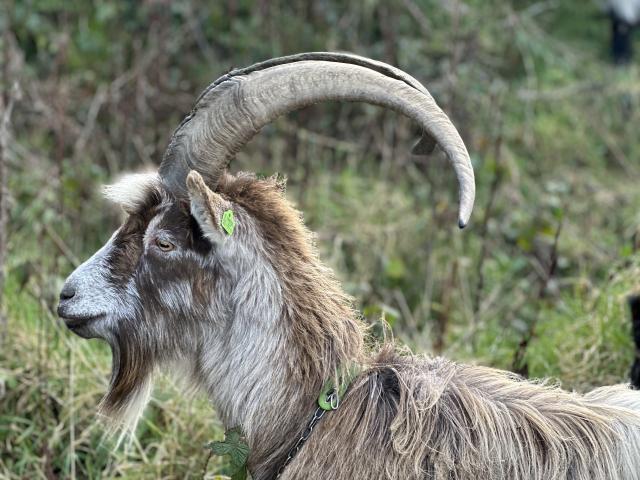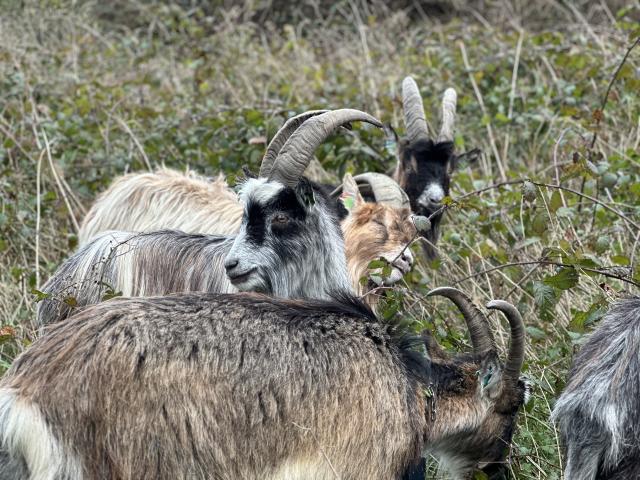Goats at Killiney Hill
We would like to apologise for any inconvenience caused, by short diversions from some small areas of Killiney hill. This is for temporary works for short periods of time, by grazing goats. Signs and fencing will be visible at locations. We ask dog owners to keep their dog on a leash when walking beside these small areas that contain goats.
Goat grazing plays an essential role in maintaining the hillside and is carried out for short periods at specific locations.
Over time, additional areas will be grazed, but the goats are only present in each location briefly and only where necessary. These grazing zones are small, carefully chosen, and strategically managed. The goats are monitored using fencing and tags to ensure they remain within designated areas. Their care and management are overseen by our dedicated goat herder and support team.
Thank you for your cooperation.
Frequently asked questions
- What is the DLR Goat Grazing Project?
This project is a collaboration between the Old Irish Goat Society (OIGS) and Dún Laoghaire-Rathdown County Council. The Old Irish Goat Grazing Project, at Dun Laoghaire-Rathdown offers a gentler nature-based solution to the increasing challenges of fire-mitigation and habitat restoration where needed. The trained herd of conservation grazers help to maintain vital firebreaks, with a non-chemical, non-mechanical and a more environmentally friendly solution. An experienced grazing team provide round the clock support and bring a wealth of grazing-project knowledge, and expert advice. The goats are fenced at all times at Killiney Hill and Roches Hill, by two physical fences and also the GPS tags on their collars that facilitate a virtual fence for management and monitoring. This ensures that they remain in the areas allocated for grazing at Killiney Hill and Roches Hill. The fence also protects them from dogs off leash.
The DLRCC Wildfire Management Plan for Killiney Hill and Mullins/Roche’s Hill has been developed by wildfire experts, ecologists, DLRCC staff, Dublin Fire Brigade and others. It has been informed by international best practice. The local residents and communities have been consulted in relation to this plan during its development.
The response from the community has been really positive and we haven’t experienced much in the way of negative feedback. However, we do understand that the project means a small change in terms of dogs-on-lead in grazing areas for some users, Killiney Hill has plenty of other areas that are available to users of the Parks. The goat grazing areas are not large and these areas are only allocated for a few weeks at a time, for grazing by the goats.
The vast majority of the public and residents want to see a solution that safe-guards the place they love and enjoy, and most have been very welcoming of this initiative.
- Is Killiney Hill also important for Biodiversity?
Yes, Killiney Hill is an important part of the Dalkey Coastal Zone and Killiney Hill proposed Natural Heritage Area (pNHA site code 001206) and also part of our DLR Ecological Network which forms part of our policies outlined in the DLRCC County Development Plan and also our County Biodiversity Action Plan. These were developed in consultation with the public. Killiney Hill also provides an important stepping stone between internationally legally protected European sites of the Natura 2000 network, both onshore and offshore, of Special Areas of Conservation (SACs) and Special Protection Areas for birds (SPAs).
Killiney Hill contains important protected species and habitats that are currently in decline on the hill largely due to human disturbances and human impacts. DLRCC have completed a Habitats and Species Management Plan (HSMP)[1] for Killiney Hill which identifies the areas that require management for protected species and habitats. The aim of the plan is to help manage areas for biodiversity and to aim to achieve a balance between the use of Killiney Hill by the public and its importance for biodiversity. The actions of the plan are being implemented and will continue over the coming years. Appropriate and well managed grazing of some habitats has been recommended as part of this plan and has been carefully considered by experienced ecological experts. Grazing does not apply to all habitats and DLRCC are not intending to graze all habitats. The natural succession of some habitats will continue at certain areas of the park.
Separately, one of the actions of the HSMP is the development of a Killiney Hill Woodland Management Plan. The woodland plan is a different and separate plan specifically aimed to restore the woodland areas which have been also impacted by human disturbance over the years. DLRCC commissioned a woodland specialist ecologist and forester with experience in woodland restoration in 2024. The plan will be finalised in 2025. This does not include goat grazing as part of this separate plan.
- Are goats going to take over the use of the entire of Killiney or Roches Hills?
No, the goats will only be grazing specific areas of both hills and only small areas over a few weeks at a time. They will not be permanently in one area; they will not roam unmanaged; and will not take up large areas of the hills. They will be in discrete areas specific to either fire breaks or ecological management of particular habitats. This is to allow users to continue to the other areas. In balance it is important to consider all life on the hills for a variety of users and for nature. Some protected habitats and species of the hills are sensitive to human disturbances which also has to be taken into account and some areas are managed for nature.
- Are all our fire breaks dominated by gorse at Killiney and Roches Hills?
No, the firebreaks vary in their habitat and structure.
Some examples given here are:
- Dalkey quarry: The fire break is mainly meadow with a small amount of bramble and gorse along the wall near houses and the road. The firebreak is a narrow width as delineated by the fire experts with input from an experienced ecologist and is not a vast area of gorse. The quarry comprises a rocky floor with thin soils and only certain habitats have developed which are a mosaic of diversity that adds to biodiversity. Trees have been planted or self seeded in places where they can take hold and provide another habitat for species. Trees and other areas of the quarry floor are not grazed and the goats are kept to the firebreak area around the edgers at all times.
- Roches Hill: Most of the habitats and gorse was burnt by wildfires over previous years, so there is little of any habitat left. The firebreaks have been designed to avoid areas where tree saplings occur and other important habitats with input from an experienced ecologist. The site is carefully managed to be sympathetic to the existing fire damage and the existing treelines, tree saplings etc. as the hill recovers from the wildfires.
- How does ecological succession of habitats relate to habitat restoration on Killiney Hill or Roches Hill?
Ecological succession is the process that describes how the structure of a biological community (that is, an interacting group of various species in a wetland, woodland, grassland, marine environment, and so on) changes over time. Species that arrive first in a newly created environment (such as an island rising out of the sea) are called pioneer species, and they, through their interactions with one another, build a rather simple initial biological community. The structure of this community becomes more complex as new species arrive on the scene and habitats develop. On Killiney Hill we have some areas which have been changed over the history of the hill through human woodland planting and residential development but there are also areas where ecological succession has happened and will continue. This must be managed however within a public park with a lot of demands, uses and challenges but we aim to manage all aspects of the park, in a sustainable manner.
Whilst ecological succession can happen over very long time periods, and some areas of Killiney Hill will be left to this process under expert ecological advice and management, the firebreaks are there for the protection of the residents that live in close proximity to Killiney and Roches Hills. Roches Hill habitats were destroyed by wildfire previously and so the recovery of those habitats will be monitored with cognisance of the fire breaks. These fire breaks are designed and are based upon the fire experts input working with ecologists. They are site specific and relevant to the conditions of each area. Therefore, firebreaks will either be cut mechanically; or grazed by goats. The goats are better for biodiversity overall and better than the use of machines. The concerns for those people who are worried about their homes, livelihoods and safety surrounding the hills, is a priority of the fire plan.
- Are the goats on Dalkey Island part of the same as the goat grazing project by DLRCC and the OIGS on Killiney Hill and Roches Hill?
No, the goats on Dalkey Island are not part of this project. It is unclear when the goats appeared in the recent history of the islands. However, it has been the subject of much debate as to when they arrived on Dalkey Island. Some non feral goats have also been placed on the island by unknow persons also although they did not appear to survive.
Cattle grazing was also referred to Samuel Lewis in 1837 and again later in the century when a mock military battle scheduled for the islands had to be cancelled because the owners of the cattle had failed to remove them.
The Dalkey Island Conservation Plan 2014-2024 states:
There is a small feral goat herd that usually numbers between six and twelve. These goats have a social value through a recently formed tradition of goats on the island. They also contribute to the wild character of the island as well as playing an important role in maintaining the ecological balance of the islands.
During the public consultations for the Dalkey Island Conservation Plan 2014-2024, it was the wish of the public that the goats were identified as of heritage value on the island. The following actions were outlined in the Conservation plan in 2014:
Action H7.4 DLR will maintain the Islands’ grazing regime through the retention of a herd of feral goats.
Action H7.5 The Goat herd to be treated as a feral herd with a policy of minimal intervention.
Action H7.6 DLR will engage a fully qualified veterinary surgeon to periodically monitor the Goat herd.
Therefore, DLRCC included the goats as part of the heritage of the island and also commissioned a vet to look after the goats and have done so ever since, to make sure that they are cared for. The presence of the goats was therefore in existence before DLRCC commenced the Killiney Hill and Roches Hill goat grazing with the OIGS. The goats on Dalkey Island are unique to the island and they are managed by DLRCC for their welfare, to ensure they come to no harm from visitors, dogs, drones etc. The vet provides the goats with nuts, additional hay, and any medications where required. The goats on Dalkey Island will be part of the new Dalkey Island Conservation Plan which is currently being drafted as we have come to the end of the previous plan. The public will have an opportunity to have their say on the new plan including on the goats on the island this year.
[1] https://www.dlrcoco.ie/sites/dlrcoco/files/2025-03/Killiney%20Hill%20Habitat%20and%20Species%20Management%20Plan.pdf






